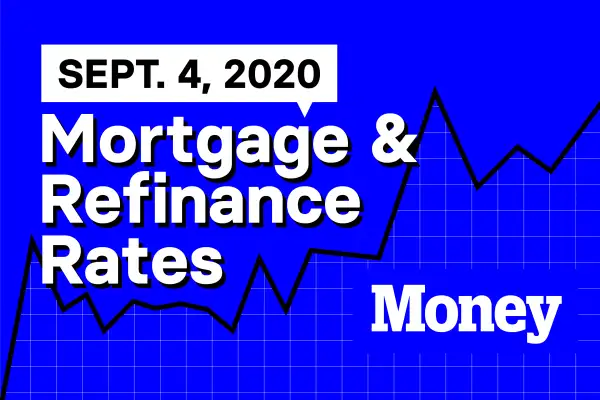Here Are Today's Best Mortgage & Refinance Rates for September 4, 2020

Borrowers with 700 credit scores were quoted an average rate of 3.398% to secure a 30-year fixed-rate purchase mortgage on Thursday, according to Money's survey of over 8,000 lenders across the United States. At this credit score, roughly the national average, the average rate for a 30-year refinance was 4.378%. Our rates include discount points and are for borrowers putting 20% down.
| 30-year fixed-rate purchase mortgage |
| 3.398% |
| Rates of September 3, 2020 |
Borrowers in Virginia were quoted the lowest mortgage rates on Thursday—at 3.263%. Those in Nevada saw the highest average rate at 3.65%. Nationwide, borrowers with the highest credit scores, 740 and above, were quoted rates averaging 3.076%, while those with credit of 640 or below were given rates of 4.897%—a 1.821 percentage point spread.
You may be able to negotiate a lower rate if you shop around or if you have other accounts with the lender. Currently, some banks are hiking up advertised rates to keep demand in check, so you may be offered a lower rate if you reach out directly.
Freddie Mac’s widely quoted Primary Mortgage Market Survey put rates at 2.93% with 0.8 discount points paid for the week ending September 3. The mortgage purchaser’s weekly survey reflects borrowers who put 20% down on conforming loans and have excellent credit.
Refinance rates today
Money's survey shows that the best rate for a 30-year refinance for someone with a 740 credit score was 3.581% on Thursday. Last September, the average mortgage rate (including fees) was 3.922%.
| 30-year fixed-rate mortgage refinance |
| 3.581% |
| Rates of September 3, 2020 |
A homeowner with a $200,000 mortgage balance currently paying 3.922% on a 30-year loan could potentially cut their monthly payment from $946 to $907 by financing at today’s lower rates. To determine if it is worth it to refinance your mortgage, also consider the closing fees you paid on your current mortgage, how much your new lender is charging and how long you have left on your current mortgage. (Our picks for the best lenders for refinancing are here.)
What else is happening in the housing market right now?
The news of today, that could impact your home tomorrow.
Lower interest rates are increasing buying power, but rising home prices mean you may be paying more than you expected. According to real estate brokerage Redfin, purchasing power for homebuyers has increased 33% year-over-year, meaning that someone with a monthly housing budget of $2,500 can afford to buy a $516,500 home (compared to $483,250 last July). This is a boon to first time home buyers who weren't able to afford a home before.
“I’m getting a lot of first-time buyers who are excited because they can finally afford a home,” said Chriss Houghton, a Redfin agent in Vancouver, WA. “People who could afford $300,000 before can now afford nearly $350,000, and the difference is a huge motivator. For some families in neighborhoods without fierce competition, the uptick in buying power allows them to purchase bigger houses with more land where more than one generation can live.”
But the housing shortage means that fewer homes are available in the affordable range, leading to higher competition for homes that are on the market and bidding wars. So you could end up with a mortgage payment equal to or slightly higher than what you would have paid at this same time last year. According to Realtor.com, a person buying a typical home today will be paying $14 more in mortgage payments than someone buying a typical home last summer.
“Lower mortgage rates can’t completely offset higher costs,” said Danielle Hale, chief economist at Realtor.com.
On the labor front, the U.S. economy added a higher than expected 1.4 million jobs during the month of August, according to the Bureau of Labor Statistics, bringing the unemployment rate below 10% to 8.4%, a drop of 1.8% from July numbers. Economists had anticipated an increase of 1.32 million jobs and an unemployment rate of 9.8%.
The report indicates a notable increase in government employment as a result of hiring for the U.S. Census but also indicated notable gains in retail, professional and business services, leisure and hospitality, as ell as education and health services. The number of unemployed fell by 2.8 million to a total of 13.6 million during August, the 4th straight month of declines. Despite the recent gains, unemployment remains high and is the biggest stumbling block to a quick economic recovery.
The Week in Review
This week in housing and economic news.
The housing market is still showing signs of a strong recovery as this week has seen mostly positive news, although concerns about a lack of inventory remain.
Sales of larger homes have increased by 21% year-over-year as buyers are looking to expand their home space, according to Redfin. Data for the week ending August 16 show that the typical home sold this year was 3.7% larger than the typical home sold last year.
The pace of sales for larger homes is nearly ten times faster than that for smaller homes. Prices for smaller homes, however, are 8.1% percent higher than last year, compared to a 7.5% increase for larger homes. Pending sales for larger homes are also up 16.1% year over year.
The Federal Housing Finance Agency announced the extension of its moratorium on single-family foreclosures and real estate owned evictions until December 31 of this year. The moratorium, which applies to loans backed by Fannie Mae and Freddie Mac had already been extended from its original expiration date of June 30 until August 31. The new extension provides protection from foreclosure to approximately 28 million homeowners.
In July, home prices were up 5.5% over last year’s prices, according to CoreLogic’sHome Price Index. The increase, however, was not consistent across all metro areas. CoreLogic’s survey also indicated that there were metro areas that were overvalued, such as Las Vegas, and could see home prices drop by as much as 7.8% by July 2021.
The number of loans in forbearance remained steady as the number of homeowners entering into the payment deferral plans equaled the number of homeowners exiting. The share of mortgage loans in forbearance remained steady at 7.20% or 3.6 million homeowners, according to the Mortgage Bankers Association.
Meanwhile, mortgage applications were down once again, slipping 2% from the previous week. Purchase loans ticked down 0.2%, but refinance loans, which have been the backbone of the mortgage lending boom, were down 3% week-over-week. Despite the delines, mortgage loan activity was up 28% and 40% year-over-year, respectively.
The Health and Human Services and the Centers for Disease Control and Prevention issued an Agency order suspending residential evictions through December 31. The move, while providing relief to some renters, places a strain on about 43 million landlords that depend on rental income. Industry leaders called for the federal government to provide some form of rental assistance to help rental property owners weather the storm.
Median listing prices increased 10%, reaching a new high of $350,000, according to Realtor.com. Housing Inventory, however, was down 36% from last year, leading to an even tighter housing market. There are 500,000 fewer homes on the market than the same week last year.
The labor market saw positive news and the number of initial claims for unemployment was lower than expected, coming in at 881,000. It’s only the second time new claims have been less than 1 million since the pandemic began. Continuing claims for unemployment benefits were also down, decreasing by 1,238,000.
Bottom line:
The Overlooked Reason It's so Hard to Buy a Home in 2020
When Will It Get Easier to Buy a Home? 8 Experts on the Nation's Housing Shortage

